yeovil at War
Caleb Edney Lewis
Killed in action in the Battle of the Somme
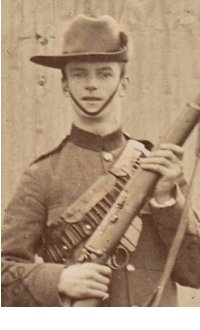 Caleb Edney
Lewis was born
in Chard in
1882, the son of
miller
James
Henry Newis
(1860-1914) and
Mary Anne née
Lucas (b 1858).
By the time of
the 1891 census
James and Mary
had moved to
Trent Corn
Mills, just east
of Yeovil, where
James described
his occupation
as Miller
(Master). They
were living at
the mill with
their three
children Caleb,
Lily and Albert,
aged 8, 6 and 4
respectively. By
1901 James and
Mary, together
with their
children and
Mary's father,
were living at
The Knoll,
Preston Road,
with solicitor
Athelstan
Rendall. James
gave his
occupation as
grain merchant
while Caleb, now
aged 18, was a
printer's
assistant.
Caleb Edney
Lewis was born
in Chard in
1882, the son of
miller
James
Henry Newis
(1860-1914) and
Mary Anne née
Lucas (b 1858).
By the time of
the 1891 census
James and Mary
had moved to
Trent Corn
Mills, just east
of Yeovil, where
James described
his occupation
as Miller
(Master). They
were living at
the mill with
their three
children Caleb,
Lily and Albert,
aged 8, 6 and 4
respectively. By
1901 James and
Mary, together
with their
children and
Mary's father,
were living at
The Knoll,
Preston Road,
with solicitor
Athelstan
Rendall. James
gave his
occupation as
grain merchant
while Caleb, now
aged 18, was a
printer's
assistant.
In 1909, at the age of 27, he married Ellen Maud Pitman Smith at Chard. They were to have two children. Caleb served in the Cyclist Section of F Company, 2nd Volunteer Battalion, Somerset Light Infantry, and later served in D Squadron, West Somerset Yeomanry (photographed above left). After his volunteer service he was a member of the Yeovil Company of the National Reserve. His military service probably accounts for the fact that in the 1911 census Ellen was living with her father and brothers on the family farm at North Perrott. Nevertheless, Caleb and Ellen lived at 'Iva', Preston Road with his mother Mary after the death of his father in 1914.
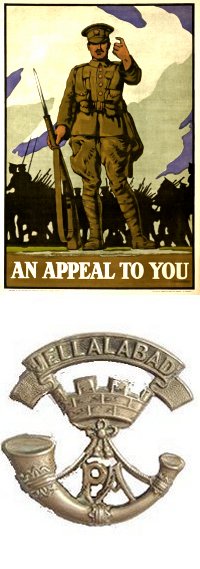 Since
Caleb was a
member of the
Yeovil Company
of the National
Reserve, he
enlisted at
Yeovil on the
outbreak of war,
joining the 6th
Battalion,
Somerset Light
Infantry
(Service No
3/7442). In fact
he may, indeed,
be one of the
men in the photograph below
of the Yeovil
Company of the
National Reserve
in the
Borough,
taken the day
war was
declared.
Since
Caleb was a
member of the
Yeovil Company
of the National
Reserve, he
enlisted at
Yeovil on the
outbreak of war,
joining the 6th
Battalion,
Somerset Light
Infantry
(Service No
3/7442). In fact
he may, indeed,
be one of the
men in the photograph below
of the Yeovil
Company of the
National Reserve
in the
Borough,
taken the day
war was
declared.
The 6th Battalion had been formed at Taunton in August 1914, becoming part of the 43rd Brigade, 14th Division at Aldershot later that year. On 21 May 1915 the 6th Battalion landed at Boulogne, France.
The Battalion spent the first week or so marching across France towards Belgium where they spent about a week supplying working parties for the digging of trenches for a secondary positions southwest of Ypres. By Sunday 13 June the Battalion settled down to trench life and the Regimental History of the Somerset Light Infantry recalled for that day "The trench life was very quiet. A little shelling early in the morning and desultory rifle fire during the day.... The trenches taken over were situated in a dangerous position. They had been captured from the enemy only a few days previously I had occupied the most easterly point of the British position in Belgium, in front of Hooge. The line generally was in a very bad state and under incessant shellfire from the North, East and South. From 30 June to 18 July the 6th Somersets remained in billets, supplying large working parties day and night."
|
A
letter
published
in the
Western
Gazette,
9 July
1915
A
letter
published
in the
Western
Gazette,
9 July
1915 In another dated 3 August before he was wounded, Private Newis says that the regiment has been under several heavy artillery bombardments during one of which they have of several more casualties including their Platoon Officer Lieutenant Hobhouse, who received a nasty shrapnel wound through the shoulder. Things have been rather warm for the past few days, but the Yeovil men have been fortunate up to the present in not receiving any further casualties. Our artillery have not been satisfied until they have the last word which was far more pleasant. Whilst he was writing, shells were passing over in both directions. He concluded: "As it was just writing this I remember that it is August Tuesday. It is twelve months yesterday that we (the National Reserve) went to Taunton for the presentation of colours. It seems more than a year ago, but a good many things have happened since then and a good many more may. We go to bed, or rather to sleep, with our clothes on just the same as we walk about and I think that if we are spared we shall be able to appreciate the many good things we have despised before now. I think it would be a great thing if the people who talk so lightly of soldiers' work out here were to be brought out here for a few days. They would be able to appreciate the work of 'Tommy' more."
A
letter
published
in the
Western
Gazette,
10 March
1916
from
"Letters
home to
Yeovil
in the
Great
War,
1914 –
1919"
by Jack
Sweet |
On 26 July 1915, while at Hooge, the Battalion was subjected to a new weapon of war - the flamethrower. This event is described in the Regimental History of the Somerset Light Infantry "Very early in the morning the front-line trenches of the Brigade were suddenly flooded by liquid fire, which belched from jets in the German lines opposite. This new device momentarily caused surprise and confusion, and the victims of this dastardly attack fell back from the front-line trenches which were then occupied by the enemy."
During 1916 the 6th Battalion fought in the trenches of the Western Front and in this year were involved in the action at Delville Wood in the Battles of the Somme. Delville Wood is to the north east of the town of Longueval in the département of the Somme in northern France.
After the two weeks of carnage from the commencement of the Somme Offensive, it became clear that a breakthrough of either the Allied or German line was most unlikely and the offensive had evolved to the capture of small prominent towns, woods or features which offered either side tactical advantages from which to direct artillery fire or to launch further attacks.
Delville Wood was one such feature, making it important to German and Allied forces. As part of a large offensive starting on 14 July, General Douglas Haig, Commander of the British Expeditionary Force, intended to secure the British right flank, while the centre advanced to capture the higher lying areas of High Wood in the centre of his line. Delville Wood was a battle to secure this right flank. The battle achieved this objective and is considered a tactical Allied victory. However, it was one of the bloodiest confrontations of the Somme, with both sides incurring large casualties.
According to the Regimental History of the Somerset Light Infantry, after the first phase of the Battle of Delville Wood, the 6th Somersets had spent several days in billets in Fricourt. During August the battalion was involved in the taking of Hop Alley and Beer Trench adjoining Delville Wood. After much heavy fighting the whole of Hop Alley passed into the hands of the Somerset men. Following the fighting, according to the Regimental History, "They dug a new CT (communication trench) under heavy fire and did it quickly and well. Also carried wire, stakes, etc, to the front line. Sent back 82 prisoners under escort. Carried bombs and sandbags. Put up artillery boards. Sent 20 men to fill gap on our left. Sent 20 men to make and hold a strong point in gap between right companies. Sent 30 men to support C company in Hop Alley. And then, when night had fallen, the remainder of this gallant company carried bombs, SAA, water, etc. to the front line."
The Regimental History continues "A little later (at 5pm) officers of the 9th Rifle Brigade came to look round the trenches of the 6th Somersets and made arrangements for taking them over. Hostile shelling, however, prevented the relief taking place until almost midnight, but this was all to the advantage of the Somerset men, who had no casualties in coming out of the line. The relief was completed at 4:15am, the battalion being billeted in Fricourt. "The men," stated the Battalion Diary, "on arrival in rest billets, were absolutely beat; the authorities had wisely kept them until the last possible moment and then taken them out." Thus ended another phase of the Battle of Delville Wood, a phase which cost the regiment five officers killed and seven wounded, with 48 other ranks killed and 220 wounded and missing. On 22 August the Brigade was paraded and the Brigadier complimented the 6th Somersets especially on the fine behaviour of the Battalion in Delville Wood."
On 26th August the 6th Battalion moved forward again to reserve trenches 300 yards in front of Bernafay Wood. Relief, however, came on 30 August, the 6th Somersets returning first to temporarily billets in Fricourt and then to a rest camp. On 31 August the Battalion entrained at Mericourt for Selincourt, 20 miles west of Amiens where, until 12 September, all ranks enjoyed a complete rest. Unfortunately almost as soon as the Battalion returned to the trenches Caleb was killed in action on 16 September 1916. He was aged 34.
The Western Gazette reported in its 13 August 1915 edition "An intimation was received on Saturday morning that Private CE Newis, of the 6th Somersets had been wounded and taken to a base hospital. An old Volunteer and Yeoman, Private Newis of Preston Road, joined the 6th Somersets at the outbreak of war with other members of the Yeovil Company of the National Reserve."
On 29 September 1916 the Western Gazette reported "Information has been conveyed to the relatives of Lance Corporal CE Newis, of Preston Road, from a friend of his serving in the Somersets at the Front, that he has been missing since an attack a week or so ago. The writer adds, that he and his friends had great hopes that Corporal Newis had been wounded and had been taken down the line somewhere where he was unable to write."
The Western Gazette reported on 20 October 1916 "Official intimation has been received by the relatives of Lance Corporal CE Newis, of Preston Road, that he has been missing since an attack on September 16th. The letter also received from the adjutant of his Battalion, after enquiries made amongst the men of his platoon, says that he can give no further information than that contained in the official notification."
The following week, on 27 October 1916, the Western Gazette wrote "The Union Jack was hung on the pulpit at the Vicarage Street Wesleyan Church on Sunday in memory of the late Corporal CE Newis of the Somerset Light Infantry. Special reference was made by the Rev. WMJ Noble, to Corporal Newis’s death, he being a member of the congregation, and had passed through all the classes of the Sunday School. Sympathy was also expressed with the relatives."
Finally, on 3 November 1916, the Western Gazette reported "Notification was received on Monday morning that Lance Corporal CE Newis, elder son of the late Mr JH Newis and Mrs Newis of Preston Road, was killed in action on September 16th. Lance Corporal Newis, who formerly served in the cyclist section of the old F Company, 2nd VB, Somerset LI, and afterwards in D Squadron, West Somerset Yeomanry, was a member of the Yeovil Company of the National Reserve, which at the outbreak of war joined a service Battalion of the Somerset Light Infantry, which has made a lasting name for itself during the war, and which will always be remembered with pride in Yeovil owing to the number of well-known men from the borough and district who have bled and died in its ranks. Corporal Newis was in partnership with his brother in the business of corn merchants and millers, carried on for many years by their father, when he left soon after the outbreak of war to commence the service of King and country which has now gloriously terminated with his life. He was 34 years of age, and leaves a widow and two young children, with whom the utmost sympathy has been expressed."
Caleb Newis is commemorated on Pier and Face 2A of the Thiepval Memorial, and his name is recorded on the War Memorial in the Borough.
gallery
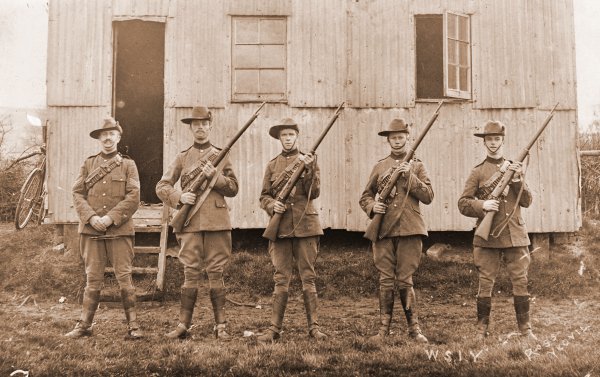
Courtesy of Jack
Sweet
Caleb Newis, at extreme right, posing with the rest of his squad of D Squadron, West Somerset Yeomanry. Photographed by William Ross around 1910.
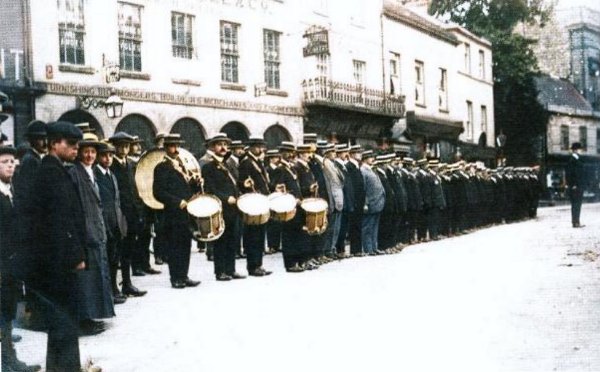
On Bank Holiday Monday, 4 August 1914, Yeovil men of 'E' (Yeovil) Company, 1st (West) Somerset Battalion of the National Reservists, known colloquially as the 'Straw Hat Brigade', line up in the Borough before marching to the Town Railway Station and travelling to Taunton. War was declared at midnight. Caleb is almost certainly in this photograph.
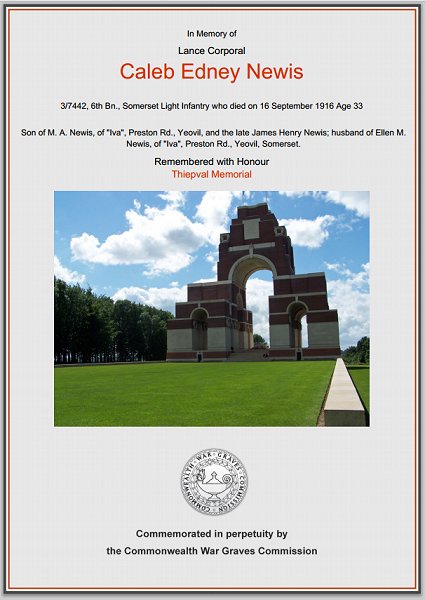
The Commonwealth War Graves Commission certificate in memory of Caleb Newis.